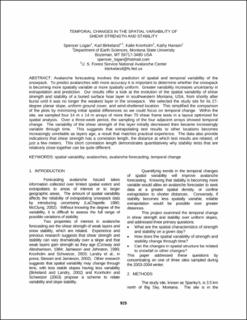Temporal changes in the spatial variability of shear strength and stability.
Chapter
Permanent lenke
https://hdl.handle.net/11250/3089946Utgivelsesdato
2006Metadata
Vis full innførselSamlinger
- NGI articles [1027]
Sammendrag
Avalanche forecasting involves the prediction of spatial and temporal variability of the snowpack. To predict avalanches with more accuracy it is important to determine whether the snowpack is becoming more spatially variable or more spatially uniform. Greater variability increases uncertainty in extrapolation and prediction. Our results offer a look at the evolution of the spatial variability of shear strength and stability of a buried surface hoar layer in southwestern Montana, USA, from shortly after burial until it was no longer the weakest layer in the snowpack. We selected the study site for its 27- degree planar slope, uniform ground cover, and wind-sheltered location. This simplified the comparison of the plots by minimizing initial spatial differences so we could focus on temporal change. Within the site, we sampled four 14 m x 14 m arrays of more than 70 shear frame tests in a layout optimized for spatial analysis. Over a three-week period, the sampling of the four adjacent arrays showed temporal change. The variability of the shear strength of this layer initially decreased then became increasingly variable through time. This suggests that extrapolating test results to other locations becomes increasingly unreliable as layers age, a result that matches practical experience. The data also provide indications that shear strength has a correlation length, the distance at which test results are related, of just a few meters. This short correlation length demonstrates quantitatively why stability tests that are relatively close together can be quite different.
